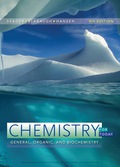
Concept explainers
(a)
Interpretation:
The natural sources for glucose are to be stated.
Concept Introduction:
Monosaccharides are the small units of simple sugars. Polysaccharides are made up of repeating units of monosaccharides. These small units are joined together by glycosidic linkage. Carbohydrates are naturally occurring organic compounds.
(b)
Interpretation:
The natural sources for fructose are to be stated.
Concept Introduction:
Monosaccharides are the small units of simple sugars. Polysaccharides are made up of repeating units of monosaccharides. These small units are joined together by glycosidic linkage. Carbohydrates are naturally occurring organic compounds.
(c)
Interpretation:
The natural sources for galactose are to be stated.
Concept Introduction:
Monosaccharides are the small units of simple sugars. Polysaccharides are made up of repeating units of monosaccharides. These small units are joined together by glycosidic linkage. Carbohydrates are naturally occurring organic compounds.
Want to see the full answer?
Check out a sample textbook solution
Chapter 17 Solutions
Chemistry for Today: General Organic and Biochemistry
- All but which of the following contain glycosidic bonds? a. Nucleotides b. Lactose c. Gangliosides d. Triacylglycerol e. Ceramide monosaccharidearrow_forwardWhich statements are correct regarding the formation of maltose?A. Hydrolysis reaction between alpha-D-glucose and beta-D-glucoseB. Condensation reaction between alpha-D-glucose and beta-D-glucoseC. Condensation reaction between beta-galactose and beta-glucoseD. Hydrolysis of starch into a di-saccharide product a). A and B b). C and D c). B and D d). B and C e). B, C and Darrow_forwardHow can distinguish among the following pairs of compound . by using . .... a. starch and sucrose b. celluloses and glucose c. glycogen acid and fructose Select one: a. Tollen's reagent b. Molish test c. lebermann reagent d. iodine testarrow_forward
- Polysaccharides are synthesized by a. plants and animals b. removal of water (dehydration synthesis) c. connecting glucose molecules together d. formation of specific glycosidic bonds between monomers e. all of thesearrow_forward49. The following compound is a(n) нонно H,N-C-C-Ñ-ċ-ċ-OH H.NCH,CH,CH,CH, H A. monosaccharide B. monopeptide C. disaccharide D. dipeptide E. diglyceridearrow_forward6. Sugar alcohols are formed by... A. Oxidizing a monosaccharide with oxygen B. Reducing a monosaccharide with copper (Cu²+) C. Hydrating a monosaccharide with water D. Hydrogenating a monosaccharide with hydrogen hove buqulodspodgory10 Aarrow_forward
- 7. In polysaccharides, monosaccharaides are joined by C. Glucose bond B. Glycosidic bond 8. Which of the following is a reducing sugar? B. Erythulos A. Covalent bond D. Peptide bond A. Dihydroxyacetone C. Glucose D. Lactose 9. Carbohydrates accounts B. 30% in plants and 10% in animals D. 50% in plants and 50% in animals A. 30% in plants and 20% in animals C. 30% in plants and 1% in animals 10. The general formula of carbohydrate is B. (C4H2O)n A. (CH2O)n C. (CoH2O)n D. (C2H2O)n COOH. 11. The sugar present in milk is_ A. Glucose B. Lactose C. Maltose D. Sucrose 12. Which one of the four classes of blologically important molecules does CELLULOSE belong to? B. lipids C. nucleic acids A. carbohydrates D. protein 13. Which of the following is a correct pair? A. Glucose : Disaccharide C. Starch : polysaccharide B. Sucrose : mionosaccharide D. Triglyceride : Polysaccharide 14, Which of the following groups are all classified as polysaccharide'? A. glycogen, cellulose and starch B. glycogen,…arrow_forwardwhat type of bond is formed between carbon and hydrogen in each monosaccharide? a. ionic bond b. polar covalent bond c. hydrogen bond d. non-polar covalent bondarrow_forwardThe aglycone portion of salicin is a sugar moiety such as glucose or rhamnose. A. True B. Falsearrow_forward
- 10. Which of the following is a monosaccharide which is used in dextrose? A. fructose C. glucose D. lactose B. galactose Which of the following is the major function of carbohydrates? 1. structural framework 2. storage 3. energy production A. 1 only Which is termed as the blueprint of life? A. deoxyribonucleic acid B. fatty acid Proteins are composed of four elements, namely: carbon, hydrogen, oxygen and 11. B. 2 only C. 3 only D. 1& 3 only 12. C. nucleic acid D. ribonucleic acid 13. what other element? A. magnesium B. nitrogen C. phosphorous D. sulfur The sugar in RNA is A. deoxyribose, ribose B. ribose, deoxyribose the sugar in DNA is C. ribose, phosphate D. ribose, uracil 14. Which is NOTa part of a nucleotide? A. nitrogenous base B. phosphate group 15. C. saturated fats D. sugararrow_forward3. How many different monosaccharides are found in honey? a. 1 O b. 2 с. 3 d. 4arrow_forwardClassify the following monosaccharide. a. alpha pyranose b. alpha furanose c. beta pyranose d. deoxy pyranose e. beta furanosearrow_forward
 Chemistry for Today: General, Organic, and Bioche...ChemistryISBN:9781305960060Author:Spencer L. Seager, Michael R. Slabaugh, Maren S. HansenPublisher:Cengage Learning
Chemistry for Today: General, Organic, and Bioche...ChemistryISBN:9781305960060Author:Spencer L. Seager, Michael R. Slabaugh, Maren S. HansenPublisher:Cengage Learning World of Chemistry, 3rd editionChemistryISBN:9781133109655Author:Steven S. Zumdahl, Susan L. Zumdahl, Donald J. DeCostePublisher:Brooks / Cole / Cengage Learning
World of Chemistry, 3rd editionChemistryISBN:9781133109655Author:Steven S. Zumdahl, Susan L. Zumdahl, Donald J. DeCostePublisher:Brooks / Cole / Cengage Learning Chemistry & Chemical ReactivityChemistryISBN:9781337399074Author:John C. Kotz, Paul M. Treichel, John Townsend, David TreichelPublisher:Cengage Learning
Chemistry & Chemical ReactivityChemistryISBN:9781337399074Author:John C. Kotz, Paul M. Treichel, John Townsend, David TreichelPublisher:Cengage Learning Chemistry & Chemical ReactivityChemistryISBN:9781133949640Author:John C. Kotz, Paul M. Treichel, John Townsend, David TreichelPublisher:Cengage LearningChemistry: Matter and ChangeChemistryISBN:9780078746376Author:Dinah Zike, Laurel Dingrando, Nicholas Hainen, Cheryl WistromPublisher:Glencoe/McGraw-Hill School Pub Co
Chemistry & Chemical ReactivityChemistryISBN:9781133949640Author:John C. Kotz, Paul M. Treichel, John Townsend, David TreichelPublisher:Cengage LearningChemistry: Matter and ChangeChemistryISBN:9780078746376Author:Dinah Zike, Laurel Dingrando, Nicholas Hainen, Cheryl WistromPublisher:Glencoe/McGraw-Hill School Pub Co Introductory Chemistry: An Active Learning Approa...ChemistryISBN:9781305079250Author:Mark S. Cracolice, Ed PetersPublisher:Cengage Learning
Introductory Chemistry: An Active Learning Approa...ChemistryISBN:9781305079250Author:Mark S. Cracolice, Ed PetersPublisher:Cengage Learning





